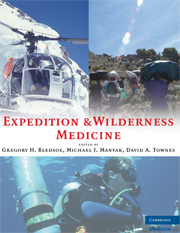Book contents
- Frontmatter
- Contents
- Contributors
- Foreword
- Preface
- Acknowledgments
- PART I EXPEDITION PLANNING
- PART II EXPEDITIONS IN UNIQUE ENVIRONMENTS
- PART III ILLNESS AND INJURIES ON EXPEDITIONS
- 24 General Medical
- 25 The Diarrhea of Travelers
- 26 Malaria: Diagnosis, Prevention, and Treatment for the Traveler
- 27 Wild Animal Attacks and Injuries
- 28 Snake and Arthropod Envenoming
- 29 Hazardous Marine Life
- 30 Expedition Toxicology
- 31 Environmental Injuries
- 32 Penetrating and Explosive Wounds
- 33 Drowning and Submersion Injury
- 34 Evaluation and Acute Resuscitation of the Trauma Patient
- 35 Principles and Practice of Expedition Wound Management
- 36 Expedition Eye Injuries and Disorders
- 37 Dental Medicine on Expedition
- 38 Foot Injuries
- 39 Expedition Orthopedics
- 40 Expedition Self-Rescue and Evacuation
- 41 Aeromedical Evacuations
- APPENDIX The Expedition Medical Kit
- Index
29 - Hazardous Marine Life
from PART III - ILLNESS AND INJURIES ON EXPEDITIONS
Published online by Cambridge University Press: 05 March 2013
- Frontmatter
- Contents
- Contributors
- Foreword
- Preface
- Acknowledgments
- PART I EXPEDITION PLANNING
- PART II EXPEDITIONS IN UNIQUE ENVIRONMENTS
- PART III ILLNESS AND INJURIES ON EXPEDITIONS
- 24 General Medical
- 25 The Diarrhea of Travelers
- 26 Malaria: Diagnosis, Prevention, and Treatment for the Traveler
- 27 Wild Animal Attacks and Injuries
- 28 Snake and Arthropod Envenoming
- 29 Hazardous Marine Life
- 30 Expedition Toxicology
- 31 Environmental Injuries
- 32 Penetrating and Explosive Wounds
- 33 Drowning and Submersion Injury
- 34 Evaluation and Acute Resuscitation of the Trauma Patient
- 35 Principles and Practice of Expedition Wound Management
- 36 Expedition Eye Injuries and Disorders
- 37 Dental Medicine on Expedition
- 38 Foot Injuries
- 39 Expedition Orthopedics
- 40 Expedition Self-Rescue and Evacuation
- 41 Aeromedical Evacuations
- APPENDIX The Expedition Medical Kit
- Index
Summary
INTRODUCTION
Due to the diversity of marine species with their range in physical size and inhabited environments, anyone who ventures into the sea has the potential to come into contact with hazardous marine life, and that encounter may result in an injury. Even though the vast majority of these are accidental and unintentional, close contact with dangerous marine life may be sought as the goal of an expedition for scientific purposes.
As a result, marine life injuries may occur and will have to be treated on-site. Fortunately, the majority of these will be minor and self-limiting if attended to promptly. In the rare instance there is a serious injury, immediate first-aid must be rendered, and evacuation must be arranged to the nearest medical facility.
Avoidance is the most important measure and certainly the easiest if everyone is well educated to the various hazardous species endemic to the area that will be visited. This, then, is the theme of what will follow in this chapter. The higher the level of awareness, the less likely an injury will occur. If a bite or envenomation should occur, those involved will have the knowledge to institute prompt treatment, potentially limiting the symptom duration with a faster recovery.
Marine life dangerous to man can be classified as those that bite and those that cause envenomations. What follows is not a comprehensive list, but rather the most common hazardous marine life that may be encountered
MARINE LIFE THAT BITE
Sharks
There are more than 350 species of sharks distributed throughout the world's oceans.
- Type
- Chapter
- Information
- Expedition and Wilderness Medicine , pp. 417 - 435Publisher: Cambridge University PressPrint publication year: 2008



